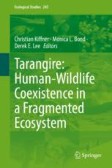Search
Search Results
-
Uncovering aquatic diversity patterns in two Patagonian glacial lakes: does habitat heterogeneity matter?
Glacially-influenced lakes are responding to global warming, improving our understanding of these threatened ecosystems is globally imperative...

-
Culturable bacterial flora of juveniles of Pelophylax ridibundus (Pallas, 1771) and influence of abiotic factors on diversity
This study aims to determine the bacterial flora on the skin surface of the juvenile forms of Pelophylax ridibundus inhabiting three different...

-
Algal blooms as a reactive dynamic response to seasonal perturbation in an experimental system
Algal blooms are typical of many aquatic freshwater ecosystems in seasonal environments. Such blooms could derive from transient reactive dynamics of...

-
Sex, mate guarding, and reproductive state as potential modulators of herbivory in an aquatic consumer
Sex-specific nutritional requirements, mating behavior, and parental care can potentially affect food selection and consumption in animals. However,...

-
Impact of meltwater flow intensity on the spatiotemporal heterogeneity of microbial mats in the McMurdo Dry Valleys, Antarctica
The meltwater streams of the McMurdo Dry Valleys are hot spots of biological diversity in the climate-sensitive polar desert landscape. Microbial...

-
Chemical Links Between Redox Conditions and Estimated Community Proteomes from 16S rRNA and Reference Protein Sequences
Environmental influences on community structure are often assessed through multivariate analyses in order to relate microbial abundances to...

-
Planktonic Centric Diatoms (Bacillariophyta, Coscinodiscaceae) of the Cheboksary Reservoir, Russia
AbstractIn 2013–2020, a total of 29 species and varieties of centric diatoms belonging to 28 genera have been found in the phytoplankton of the...

-
Ungulate Populations in the Tarangire Ecosystem
Savanna ecosystems support the highest diversities of hoofed mammal (ungulate) species in the world. Ungulates provide critical ecosystem services...
-
Behavioral habitat selection of wood bison (Bison bison athabascae) in boreal forests
Habitat selection is critical to informing wildlife management and conservation. However, different behaviors require the use of different habitat...

-
Estimating microbial mat biomass in the McMurdo Dry Valleys, Antarctica using satellite imagery and ground surveys
Cyanobacterial mat communities are the main drivers of primary productivity in the McMurdo Dry Valleys, Antarctica. These microbial communities form...

-
Why didn’t the caribou (Rangifer tarandus groenlandicus) cross the winter road? The effect of industrial traffic on the road-crossing decisions of caribou
Populations of barren-ground caribou have declined steeply due to the combined effects of climate change, natural fluctuations, human harvest, and...

-
Metabolites, Molecular Diversity, and Applications of Cyanobacteria in the Beverage Industry
The chapter explores the metabolites, molecular diversity, and application of cyanobacteria in the beverage sector. Information in the chapter was...
-
Rapid adjustment of cone opsin expression profiles may help Western mosquitofish (Gambusia affinis) maintain foraging efficiency in distinct light environments
Vertebrates rely on two special groups of photoreceptor cells (rods and cones) in the retina to receive visual information. Five opsin families in...

-
Prey adaptation along a competition-defense tradeoff cryptically shifts trophic cascades from density- to trait-mediated
Trophic cascades have become a dominant paradigm in ecology, yet considerable debate remains about the relative strength of density- (consumptive)...

-
Naming New Taxa of Prokaryotes: Rules and Recommendations
The nomenclature of prokaryotes is regulated by the rules of the International Code of Nomenclature of Prokaryotes (ICNP; the Prokaryotic Code). The...
-
Movement Characteristics and Habitat Use of Sika Deer in Kanto Region, Central Japan
We aimed to clarify the seasonal movement, activity range, and habitat use of sika deer (Cervus nippon) in OzeOze and OkuchichibuOkuchichibu areas,...
-
Ecological Characteristics of Antarctic Fungi
AbstractIn view of the high responsiveness of polar ecosystems to the global climate change, the research of Antarctic microorganisms has become a...

-
Size is not everything: differing activity and foraging patterns between the sexes in a monomorphic mammal
AbstractAnimals balance foraging with other activities, and activity patterns may differ between sexes due to differing physical requirements and...

-
Population regulation in the deer mouse (Peromyscus maniculatus) in old-growth coniferous forests of southern British Columbia: insights from a long-term study
We report a 26-year detailed record of changes in abundance and demography of the deer mouse ( Peromyscus maniculatus ) in old-growth coniferous forest...

-
Movement Patterns and Activity Range Characteristics of Sika Deer in the Tanzawa Mountains, Central Japan
To understand the characteristics of movement and activity rangeActivity range of sika deer (Cervus nippon), we tracked 42 individuals (33 females, 9...
